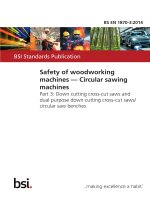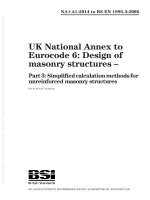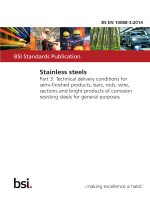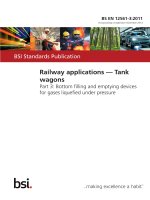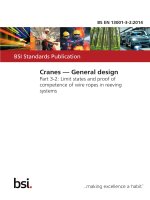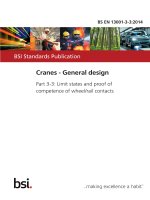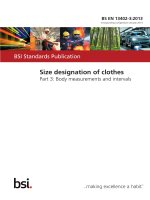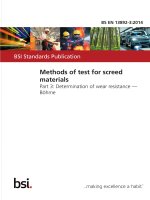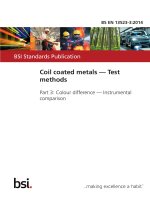Bsi bs en 61158 3 3 2014
Bạn đang xem bản rút gọn của tài liệu. Xem và tải ngay bản đầy đủ của tài liệu tại đây (1.46 MB, 72 trang )
BS EN 61158-3-3:2014
BSI Standards Publication
Industrial communication
networks — Fieldbus
specifications
Part 3-3: Data-link layer service
definition — Type 3 elements
BRITISH STANDARD
BS EN 61158-3-3:2014
National foreword
This British Standard is the UK implementation of EN 61158-3-3:2014. It
is identical to IEC 61158-3-3:2014. It supersedes BS EN 61158-3-3:2008
which is withdrawn.
The UK participation in its preparation was entrusted to Technical
Committee AMT/7, Industrial communications: process measurement and
control, including fieldbus.
A list of organizations represented on this committee can be obtained on
request to its secretary.
This publication does not purport to include all the necessary provisions of
a contract. Users are responsible for its correct application.
© The British Standards Institution 2014.
Published by BSI Standards Limited 2014
ISBN 978 0 580 79363 9
ICS 25.040.40; 35.100.20; 35.240.50
Compliance with a British Standard cannot confer immunity from
legal obligations.
This British Standard was published under the authority of the
Standards Policy and Strategy Committee on 31 October 2014.
Amendments/corrigenda issued since publication
Date
Text affected
EUROPEAN STANDARD
EN 61158-3-3
NORME EUROPÉENNE
EUROPÄISCHE NORM
October 2014
ICS 25.040.40; 35.100.20; 35.110
Supersedes EN 61158-3-3:2008
English Version
Industrial communication networks - Fieldbus specifications Part 3-3: Data-link layer service definition - Type 3 elements
(IEC 61158-3-3:2014)
Réseaux de communication industriels - Spécifications des
bus de terrain - Partie 3-3: Définition des services de la
couche liaison de données - Éléments de type 3
(CEI 61158-3-3:2014)
Industrielle Kommunikationsnetze - Feldbusse - Teil 3-3:
Dienstfestlegungen des Data Link Layer
(Sicherungsschicht) - Typ 3-Elemente
(IEC 61158-3-3:2014)
This European Standard was approved by CENELEC on 2014-09-17. CENELEC members are bound to comply with the CEN/CENELEC
Internal Regulations which stipulate the conditions for giving this European Standard the status of a national standard without any alteration.
Up-to-date lists and bibliographical references concerning such national standards may be obtained on application to the CEN-CENELEC
Management Centre or to any CENELEC member.
This European Standard exists in three official versions (English, French, German). A version in any other language made by translation
under the responsibility of a CENELEC member into its own language and notified to the CEN-CENELEC Management Centre has the
same status as the official versions.
CENELEC members are the national electrotechnical committees of Austria, Belgium, Bulgaria, Croatia, Cyprus, the Czech Republic,
Denmark, Estonia, Finland, Former Yugoslav Republic of Macedonia, France, Germany, Greece, Hungary, Iceland, Ireland, Italy, Latvia,
Lithuania, Luxembourg, Malta, the Netherlands, Norway, Poland, Portugal, Romania, Slovakia, Slovenia, Spain, Sweden, Switzerland,
Turkey and the United Kingdom.
European Committee for Electrotechnical Standardization
Comité Européen de Normalisation Electrotechnique
Europäisches Komitee für Elektrotechnische Normung
CEN-CENELEC Management Centre: Avenue Marnix 17, B-1000 Brussels
© 2014 CENELEC All rights of exploitation in any form and by any means reserved worldwide for CENELEC Members.
Ref. No. EN 61158-3-3:2014 E
BS EN 61158-3-3:2014
EN 61158-3-3:2014
-2-
Foreword
The text of document 65C/759/FDIS, future edition 2 of IEC 61158-3-3, prepared by SC 65C
"Industrial networks" of IEC/TC 65 "Industrial-process measurement, control and automation" was
submitted to the IEC-CENELEC parallel vote and approved by CENELEC as EN 61158-3-3:2014.
The following dates are fixed:
•
latest date by which the document has to be implemented at
national level by publication of an identical national
standard or by endorsement
(dop)
2015-06-17
•
latest date by which the national standards conflicting with
the document have to be withdrawn
(dow)
2017-09-17
This document supersedes EN 61158-3-3:2008.
Attention is drawn to the possibility that some of the elements of this document may be the subject of
patent rights. CENELEC [and/or CEN] shall not be held responsible for identifying any or all such
patent rights.
This document has been prepared under a mandate given to CENELEC by the European Commission
and the European Free Trade Association.
Endorsement notice
The text of the International Standard IEC 61158-3-3:2014 was approved by CENELEC as a
European Standard without any modification.
In the official version, for Bibliography, the following notes have to be added for the standards indicated:
IEC 61158-2
NOTE
Harmonized as EN 61158-2.
IEC 61158-4-3
NOTE
Harmonized as EN 61158-4-3.
IEC 61158-5-3
NOTE
Harmonized as EN 61158-5-3.
IEC 61158-6-3
NOTE
Harmonized as EN 61158-6-3.
BS EN 61158-3-3:2014
EN 61158-3-3:2014
-3-
Annex ZA
(normative)
Normative references to international publications
with their corresponding European publications
The following documents, in whole or in part, are normatively referenced in this document and are
indispensable for its application. For dated references, only the edition cited applies. For undated
references, the latest edition of the referenced document (including any amendments) applies.
NOTE 1
When an International Publication has been modified by common modifications, indicated by (mod),
the relevant EN/HD applies.
NOTE 2
Up-to-date information on the latest versions of the European Standards listed in this annex is
available here: www.cenelec.eu.
Publication
Year
Title
EN/HD
Year
IEC 61158-1
-
Industrial communication networks Fieldbus specifications Part 1: Overview and guidance for the
IEC 61158 and IEC 61784 series
EN 61158-1
-
ISO/IEC 7498-1
-
Information technology - Open Systems
Interconnection - Basic Reference Model:
The Basic Model
-
-
ISO/IEC 7498-3
-
Information technology - Open Systems
Interconnection - Basic Reference Model:
Naming and addressing
-
-
ISO/IEC 10731
-
Information technology - Open Systems
Interconnection - Basic Reference Model Conventions for the definition of OSI
services
-
-
–2–
BS EN 61158-3-3:2014
IEC 61158-3-3:2014 © IEC 2014
CONTENTS
INTRODUCTION ..................................................................................................................... 7
1
Scope ............................................................................................................................... 8
2
1.1 General ................................................................................................................... 8
1.2 Specifications .......................................................................................................... 8
1.3 Conformance ........................................................................................................... 9
Normative references ....................................................................................................... 9
3
Terms, definitions, symbols, abbreviations and conventions ............................................. 9
4
3.1 Reference model terms and definitions .................................................................... 9
3.2 Service convention terms and definitions ............................................................... 11
3.3 Common data-link service terms and definitions .................................................... 12
3.4 Additional Type 3 data-link specific definitions....................................................... 13
3.5 Common symbols and abbreviations ..................................................................... 15
3.6 Additional Type 3 symbols and abbreviations ........................................................ 16
3.7 Common conventions ............................................................................................ 18
3.8 Additional Type 3 conventions ............................................................................... 19
Connectionless-mode data-link service ........................................................................... 20
5
4.1 General ................................................................................................................. 20
4.2 Model of the connectionless-mode data-link service .............................................. 20
4.3 Sequence of primitives .......................................................................................... 22
4.4 Detailed description of DL services........................................................................ 25
DL-management Service ................................................................................................ 44
5.1 General ................................................................................................................. 44
5.2 Facilities of the DLMS ........................................................................................... 44
5.3 Services of the DL-management ............................................................................ 45
5.4 Overview of interactions ........................................................................................ 46
5.5 Detailed specification of services and interactions ................................................. 48
Bibliography .......................................................................................................................... 68
Figure 1 – Relationships of DLSAPs, DLSAP-addresses and group DL-addresses ................ 12
Figure 2 – SDA service ......................................................................................................... 23
Figure 3 – SDN service ......................................................................................................... 23
Figure 4 – SRD service ......................................................................................................... 23
Figure 5 – MSRD service ...................................................................................................... 24
Figure 6 – CS service ........................................................................................................... 24
Figure 7 – Reset, Set value, Get value, Ident (local), DLSAP status, DLSAP activate,
DLSAP activate responder, DLSAP activate subscriber and DLSAP deactivate services ....... 47
Figure 8 – Event service ....................................................................................................... 47
Figure 9 – Ident (remote) service .......................................................................................... 48
Table 1 – Summary of DL services and primitives ................................................................. 22
Table 2 – SDA data ack primitives and parameters ............................................................... 26
Table 3 – Values of DL_status for the SDA data ack service ................................................. 28
Table 4 – SDN data primitives and parameters ..................................................................... 29
BS EN 61158-3-3:2014
IEC 61158-3-3:2014 © IEC 2014
–3–
Table 5 – Values of DL_status for the SDN data service ....................................................... 31
Table 6 – SRD data reply primitives and parameters ............................................................. 32
Table 7 – Values of Update_status for the SRD data reply service ........................................ 33
Table 8 – Additional values of DL_status for the SRD data reply service ............................... 34
Table 9 – SRD reply-update primitives and parameters ......................................................... 34
Table 10 – Values of DL_status for the SRD reply-update service ......................................... 36
Table 11 – MSRD MCT data reply primitives and parameters ................................................ 37
Table 12 – MSRD DXM data reply primitive and parameters ................................................. 39
Table 13 – CS time event primitives and parameters ............................................................ 41
Table 14 – Values of DL_status for the CS time event service .............................................. 42
Table 15 – CS clock value primitives and parameters ........................................................... 42
Table 16 – Values of CS_status for the CS clock value service ............................................. 44
Table 17 – Values of DL_status for the CS clock value service ............................................. 44
Table 18 – Summary of DL-management services and primitives .......................................... 47
Table 19 – Reset primitives and parameters ......................................................................... 48
Table 20 – Values of DLM_status for the reset service .......................................................... 48
Table 21 – Set value primitives and parameters .................................................................... 49
Table 22 – Mandatory DLE-variables .................................................................................... 50
Table 23 – Optional DLE-variables ........................................................................................ 50
Table 24 – Permissible values of mandatory DLE-variables .................................................. 51
Table 25 – Permissible values of optional DLE-variables ...................................................... 51
Table 26 – Meaning of the values for the parameter isochronous_mode ............................... 52
Table 27 – Default reaction times and operating parameters for a master station for
asynchronous transmission ................................................................................................... 52
Table 28 – Default reaction times and operating parameters for a slave station with
asynchronous transmission ................................................................................................... 52
Table 29 – Default reaction times and operating parameters for master stations for
coupling of synchronous and asynchronous transmission segments...................................... 53
Table 30 – Default reaction times and operating parameter for slave stations for
coupling of synchronous and asynchronous transmission segments...................................... 53
Table 31 – Values of DLM_status for the set value service ................................................... 53
Table 32 – Get value primitives and parameters ................................................................... 54
Table 33 – Additional mandatory DLE-variables in master stations ....................................... 54
Table 34 – Permissible values of the additional DLE-variables in master stations ................. 55
Table 35 – Values of DLM_status for the get value service ................................................... 55
Table 36 – Event primitive and parameters ........................................................................... 55
Table 37 – Mandatory DLL events and fault types ................................................................. 56
Table 38 – Permissible values of T SH ................................................................................... 56
Table 39 – Ident primitives and parameters .......................................................................... 57
Table 40 – Ident_list for the ident service .............................................................................. 57
Table 41 – Values of DLM_status for the ident service (local) ............................................... 58
Table 42 – Values of DLM_status for the ident service (remote) ............................................ 58
Table 43 – DLSAP status primitives and parameters ............................................................. 58
Table 44 – Values of DLM_status for the DLSAP status service ............................................ 59
–4–
BS EN 61158-3-3:2014
IEC 61158-3-3:2014 © IEC 2014
Table 45 – DLSAP activate primitives and parameters .......................................................... 60
Table 46 – DLSAP activate service_list ................................................................................. 60
Table 47 – DLSAP activate DLSDU_length_list (SDA, SDN, SRD, MSRD and CS) ................ 61
Table 48 – DLSDU lengths of SDA and SDN as used in the DLSAP activate service ............. 62
Table 49 – DLSDU lengths of SRD and MSRD as used in the (master station) DLSAP
activate service ..................................................................................................................... 62
Table 50 – DLSDU lengths of CS as used in the DLSAP activate service .............................. 62
Table 51 – Values of DLM_status for the DLSAP activate service ......................................... 62
Table 52 – DLSAP activate responder primitives and parameters ......................................... 63
Table 53 – DLSDU_length_list for the DLSAP activate responder service ............................. 63
Table 54 – DLSDU length of SRD and MSRD as used in the DLSAP activate responder
service .................................................................................................................................. 64
Table 55 – Values of DLM_status for the DLSAP activate responder service ........................ 65
Table 56 – DLSAP activate subscriber primitives and parameters ......................................... 65
Table 57 – DLSDU_length_list for the DLSAP activate subscriber service ............................. 66
Table 58 – DLSDU lengths of MSRD as used in the DLSAP activate subscriber service
(master and slave stations) ................................................................................................... 66
Table 59 – Values of DLM_status for the DLSAP activate subscriber service ........................ 66
Table 60 – DLSAP deactivate primitives and parameters ...................................................... 67
Table 61 – Values of DLM_status for the DLSAP deactivate service ..................................... 67
BS EN 61158-3-3:2014
IEC 61158-3-3:2014 © IEC 2014
–7–
INTRODUCTION
This part of IEC 61158 is one of a series produced to facilitate the interconnection of
automation system components. It is related to other standards in the set as defined by the
“three-layer” fieldbus reference model described in IEC 61158-1.
Throughout the set of fieldbus standards, the term “service” refers to the abstract capability
provided by one layer of the OSI Basic Reference Model to the layer immediately above.
Thus, the data-link layer service defined in this standard is a conceptual architectural service,
independent of administrative and implementation divisions.
–8–
BS EN 61158-3-3:2014
IEC 61158-3-3:2014 © IEC 2014
INDUSTRIAL COMMUNICATION NETWORKS –
FIELDBUS SPECIFICATIONS –
Part 3-3: Data-link layer service definition –
Type 3 elements
1
1.1
Scope
General
This part of IEC 61158 provides common elements for basic time-critical messaging
communications between devices in an automation environment. The term “time-critical” is
used to represent the presence of a time-window, within which one or more specified actions
are required to be completed with some defined level of certainty. Failure to complete
specified actions within the time window risks failure of the applications requesting the
actions, with attendant risk to equipment, plant and possibly human life.
This standard defines in an abstract way the externally visible service provided by the Type 3
fieldbus data-link layer in terms of
a) the primitive actions and events of the service;
b) the parameters associated with each primitive action and event, and the form which they
take; and
c) the interrelationship between these actions and events, and their valid sequences.
The purpose of this standard is to define the services provided to
–
the Type 3 fieldbus application layer at the boundary between the application and data-link
layers of the fieldbus reference model, and
–
systems management at the boundary between the data-link layer and systems
management of the fieldbus reference model.
1.2
Specifications
The principal objective of this standard is to specify the characteristics of conceptual data-link
layer services suitable for time-critical communications, and thus supplement the OSI Basic
Reference Model in guiding the development of data-link protocols for time-critical
communications. A secondary objective is to provide migration paths from previously existing
industrial communications protocols.
This specification may be used as the basis for formal DL-Programming-Interfaces.
Nevertheless, it is not a formal programming interface, and any such interface will need to
address implementation issues not covered by this specification, including
a) the sizes and octet ordering of various multi-octet service parameters, and
b) the correlation of paired request and confirm, or indication and response, primitives.
BS EN 61158-3-3:2014
IEC 61158-3-3:2014 © IEC 2014
1.3
–9–
Conformance
This standard does not specify individual implementations or products, nor do they constrain
the implementations of data-link entities within industrial automation systems.
There is no conformance of equipment to this data-link layer service definition standard.
Instead, conformance is achieved through implementation of the corresponding data-link
protocol that fulfills the Type 1 data-link layer services defined in this standard.
2
Normative references
The following documents, in whole or in part, are normatively referenced in this document and
are indispensable for its application. For dated references, only the edition cited applies. For
undated references, the latest edition of the referenced document (including any
amendments) applies.
NOTE All parts of the IEC 61158 series, as well as IEC 61784-1 and IEC 61784-2 are maintained simultaneously.
Cross-references to these documents within the text therefore refer to the editions as dated in this list of normative
references.
IEC 61158-1, Industrial communication networks – Fieldbus specifications – Part 1: Overview
and guidance for the IEC 61158 and IEC 61784 series
ISO/IEC 7498-1, Information technology – Open Systems Interconnection – Basic Reference
Model – Basic Reference Model: The Basic Model
ISO/IEC 7498-3, Information technology – Open Systems Interconnection – Basic Reference
Model: Naming and addressing
ISO/IEC 10731, Information technology – Open Systems Interconnection – Basic Reference
Model – Conventions for the definition of OSI services
3
Terms, definitions, symbols, abbreviations and conventions
For the purposes of this document, the following terms, definitions, symbols, abbreviations
and conventions apply.
3.1
Reference model terms and definitions
This standard is based in part on the concepts developed in ISO/IEC 7498-1 and
ISO/IEC 7498-3, and makes use of the following terms defined therein.
3.1.1
DL-address
[7498-3]
3.1.2
DL-address-mapping
[7498-1]
3.1.3
called-DL-address
[7498-3]
3.1.4
calling-DL-address
[7498-3]
3.1.5
centralized multi-end-point-connection
[7498-1]
3.1.6
DL-connection
[7498-1]
– 10 –
BS EN 61158-3-3:2014
IEC 61158-3-3:2014 © IEC 2014
3.1.7
DL-connection-end-point
[7498-1]
3.1.8
DL-connection-end-point-identifier
[7498-1]
3.1.9
DL-connection-mode transmission
[7498-1]
3.1.10
DL-connectionless-mode transmission
[7498-1]
3.1.11
correspondent (N)-entities
correspondent DL-entities (N=2)
correspondent Ph-entities (N=1)
[7498-1]
3.1.12
DL-duplex-transmission
[7498-1]
3.1.13
(N)-entity
DL-entity (N=2)
Ph-entity (N=1)
[7498-1]
3.1.14
DL-facility
[7498-1]
3.1.15
flow control
[7498-1]
3.1.16
(N)-layer
DL-layer (N=2)
Ph-layer (N=1)
[7498-1]
3.1.17
layer-management
[7498-1]
3.1.18
DL-local-view
[7498-3]
3.1.19
DL-name
[7498-3]
3.1.20
naming-(addressing)-domain
[7498-3]
3.1.21
peer-entities
[7498-1]
3.1.22
primitive name
[7498-3]
3.1.23
DL-protocol
[7498-1]
3.1.24
DL-protocol-connection-identifier
[7498-1]
3.1.25
DL-protocol-data-unit
[7498-1]
3.1.26
DL-relay
[7498-1]
3.1.27
reset
[7498-1]
3.1.28
responding-DL-address
[7498-3]
3.1.29
routing
[7498-1]
3.1.30
segmenting
[7498-1]
3.1.31
(N)-service
DL-service (N=2)
Ph-service (N=1)
[7498-1]
3.1.32
(N)-service-access-point
DL-service-access-point (N=2)
Ph-service-access-point (N=1)
[7498-1]
3.1.33
DL-service-access-point-address
[7498-3]
BS EN 61158-3-3:2014
IEC 61158-3-3:2014 © IEC 2014
– 11 –
3.1.34
DL-service-connection-identifier
[7498-1]
3.1.35
DL-service-data-unit
[7498-1]
3.1.36
DL-simplex-transmission
[7498-1]
3.1.37
DL-subsystem
[7498-1]
3.1.38
systems-management
[7498-1]
3.1.39
DLS-user-data
[7498-1]
3.2
Service convention terms and definitions
This standard also makes use of the following terms defined in ISO/IEC 10731 as they apply
to the data-link layer:
3.2.1
acceptor
3.2.2
asymmetrical service
3.2.3
confirm (primitive);
requestor.deliver (primitive)
3.2.4
deliver (primitive)
3.2.5
DL-confirmed-facility
3.2.6
DL-facility
3.2.7
DL-local-view
3.2.8
DL-mandatory-facility
3.2.9
DL-non-confirmed-facility
3.2.10
DL-provider-initiated-facility
3.2.11
DL-provider-optional-facility
3.2.12
DL-service-primitive;
primitive
3.2.13
DL-service-provider
3.2.14
DL-service-user
3.2.15
DLS-user-optional-facility
3.2.16
indication (primitive);
acceptor.deliver (primitive)
3.2.17
multi-peer
3.2.18
request (primitive);
requestor.submit (primitive)
3.2.19
requestor
3.2.20
response (primitive);
acceptor.submit (primitive)
3.2.21
submit (primitive)
3.2.22
symmetrical service
– 12 –
3.3
BS EN 61158-3-3:2014
IEC 61158-3-3:2014 © IEC 2014
Common data-link service terms and definitions
For the purposes of this document, the following terms and definitions apply.
NOTE Many definitions are common to more than one protocol Type; they are not necessarily used by all protocol
Types.
3.3.1
DL-segment,
link,
local link
single DL-subnetwork in which any of the connected DLEs may communicate directly, without
any intervening DL-relaying, whenever all of those DLEs that are participating in an instance
of communication are simultaneously attentive to the DL-subnetwork during the period(s) of
attempted communication
3.3.2
DLSAP
distinctive point at which DL-services are provided by a single DL-entity to a single higherlayer entity
Note 1 to entry: This definition, derived from ISO/IEC 7498-1, is repeated here to facilitate understanding of the
critical distinction between DLSAPs and their DL-addresses.
NOTE 1
DLSAPs and PhSAPs are depicted as ovals spanning the boundary between two adjacent layers.
NOTE 2
DL-addresses are depicted as designating small gaps (points of access) in the DLL portion of a DLSAP.
NOTE 3 A single DL-entity may have multiple DLSAP-addresses and group DL-addresses associated with a
single DLSAP.
Figure 1 – Relationships of DLSAPs, DLSAP-addresses and group DL-addresses
BS EN 61158-3-3:2014
IEC 61158-3-3:2014 © IEC 2014
– 13 –
3.3.3
DL(SAP)-address
either an individual DLSAP-address, designating a single DLSAP of a single DLS-user, or a
group DL-address potentially designating multiple DLSAPs, each of a single DLS-user
Note 1 to entry: This terminology is chosen because ISO/IEC 7498-3 does not permit the use of the term DLSAPaddress to designate more than a single DLSAP at a single DLS-user.
3.3.4
(individual) DLSAP-address
DL-address that designates only one DLSAP within the extended link
Note 1 to entry:
A single DL-entity may have multiple DLSAP-addresses associated with a single DLSAP.
3.3.5
extended link
DL-subnetwork, consisting of the maximal set of links interconnected by DL-relays, sharing a
single DL-name (DL-address) space, in which any of the connected DL-entities may
communicate, one with another, either directly or with the assistance of one or more of those
intervening DL-relay entities
Note 1 to entry:
An extended link may be composed of just a single link.
3.3.6
frame
denigrated synonym for DLPDU
3.3.7
group DL-address
DL-address that potentially designates more than one DLSAP within the extended link
Note 1 to entry:
A single DL-entity can have multiple group DL-addresses associated with a single DLSAP.
Note 2 to entry:
DLSAP.
A single DL-entity also can have a single group DL-address associated with more than one
3.3.8
node
single DL-entity as it appears on one local link
3.3.9
receiving DLS-user
DL-service user that acts as a recipient of DLS-user-data
Note 1 to entry:
A DL-service user can be concurrently both a sending and receiving DLS-user.
3.3.10
sending DLS-user
DL-service user that acts as a source of DLS-user-data
3.4
Additional Type 3 data-link specific definitions
For the purposes of this document, the following terms and definitions apply.
3.4.1
acknowledgement DLPDU
reply DLPDU that contains no DLSDU
3.4.2
bit time
time to transmit one bit
– 14 –
BS EN 61158-3-3:2014
IEC 61158-3-3:2014 © IEC 2014
3.4.3
clock synchronization
represents a sequence of interactions to synchronize the clocks of all time receivers by a time
master
3.4.4
controller_type
hardware class of the communications entity
3.4.5
data DLPDU
DLPDU that carries a DLSDU from a local DLS-user to a remote DLS-user
3.4.6
DL_status, DLM_status
status that specifies the result of the execution of the associated request
3.4.7
GAP
range of station (DLE) DL-addresses from this station (TS) to its successor (NS) in the logical
token ring, excluding stations above HSA
3.4.8
isochronous mode
special operational mode that implies both a constant (isochronous) cycle with a fixed
schedule of high and low priority messages, and the synchronization of the DLS-users with
this constant (isochronous) cycle
3.4.9
local DLE
DLE in a current master station that initiates the current transaction
3.4.10
local DLS-user
DLS-user that initiates the current service
3.4.11
publisher
transmitter of messages for consumption by subscribers
3.4.12
region/segment address
address extension that identifies a particular fieldbus subnetwork
Note 1 to entry:
This supports DL-routing between fieldbuses.
3.4.13
remote DLE
addressed DLE of a service request (that is, the intended receiving DLE of any resulting
request DLPDU)
3.4.14
remote DLS-user
addressed DLS-user of a service request (that is, the intended receiver of any resulting
indication primitive)
BS EN 61158-3-3:2014
IEC 61158-3-3:2014 © IEC 2014
– 15 –
3.4.15
reply DLPDU
DLPDU transmitted from a remote DLE to the initiating (local) DLE, and possibly other DLEs
Note 1 to entry:
When the remote DLE is a Publisher, the reply DLPDU also can be sent to several remote DLEs.
3.4.16
request DLPDU
DLPDU that carries either a request for data or a DLSDU or both from a local DLS-user to a
remote DLS-user
3.4.17
response DLPDU
reply DLPDU that carries a DLSDU from a remote DLS-user to local DLS-user
3.4.18
station
master or slave device containing a DLE
3.4.19
subscriber
receiver of messages produced by a publisher
3.4.20
time event
message that represents a trigger for a moment of time
3.4.21
time master
device which is able to send clock synchronization messages
Note 1 to entry:
Link devices have time master functionality.
3.4.22
time receiver
fieldbus device able to be time synchronized by a time master
3.4.23
token passing
medium access method, in which the right to transmit is passed from master station to master
station in a logical ring
3.5
Common symbols and abbreviations
NOTE Many symbols and abbreviations are common to more than one protocol Type; they are not necessarily
used by all protocol Types.
3.5.1
DL-
data-link layer (as a prefix)
3.5.2
DLC
DL-connection
3.5.3
DLCEP
DL-connection-end-point
3.5.4
DLE
DL-entity (the local active instance of the data-link layer)
3.5.5
DLL
DL-layer
3.5.6
DLPCI
DL-protocol-control-information
– 16 –
BS EN 61158-3-3:2014
IEC 61158-3-3:2014 © IEC 2014
3.5.7
DLPDU
DL-protocol-data-unit
3.5.8
DLM
DL-management
3.5.9
DLME
DL-management Entity (the local active instance of
DL-management)
3.5.10
DLMS
DL-management Service
3.5.11
DLS
DL-service
3.5.12
DLSAP
DL-service-access-point
3.5.13
DLSDU
DL-service-data-unit
3.5.14
FIFO
first-in first-out (queuing method)
3.5.15
OSI
open systems interconnection
3.5.16
Ph-
physical layer (as a prefix)
3.5.17
PhE
Ph-entity (the local active instance of the physical layer)
3.5.18
PhL
Ph-layer
3.5.19
QoS
quality of service
3.6
Additional Type 3 symbols and abbreviations
3.6.1
ACK
acknowledge(ment) DLPDU
3.6.2
cnf
confirm primitive
3.6.3
CS
clock synchronization
3.6.4
DA
destination address of a DLPDU
3.6.5
DAE
destination address extension(s) of a DLPDU which conveys
D_SAP_index or destination region/segment address or both
3.6.6
DS
DL/DLM_status: Disconnected station, local DL-entity not in logical
token ring or disconnected from line
3.6.7
D_SAP
destination service access point, the DLSAP which identifies the
remote DLS-user.
3.6.8
D_SAP_index
destination service access point index, that component of a DLSAPaddress which designates a DLSAP and remote DLS-user within the
remote DLE
3.6.9
DXM
data exchange multicast
3.6.10
EXT
address extension bit of a DLPDU
3.6.11
FC
frame control (DLPDU type) field of a DLPDU
3.6.12
G
GAP update factor, the number of token cycles between GAP
maintenance (update) cycles
3.6.13
HSA
highest station address installed (configured) on this fieldbus
3.6.14
ind
indication primitive
3.6.15
IsoM
isochronous mode
BS EN 61158-3-3:2014
IEC 61158-3-3:2014 © IEC 2014
– 17 –
3.6.16
LMS
list of master stations
3.6.17
LR
DL/DLM_status: Local resource not available or not sufficient
3.6.18
LS
DL/DLM_status: Local service not activated at DLSAP or local
DLSAP not activated
3.6.19
MSRD
send and request data with multicast reply (DL-service)
3.6.20
NA
DL/DLM_status: No acknowledgement/response
3.6.21
NIL
locally existing value, but not fixed
3.6.22
NO
DL/DLM_status: Not ok
3.6.23
NR
DL/DLM_status: No response, DL/DLM-data acknowledgement
negative and send data ok
3.6.24
NS
Next station, the station to which this Master will pass the token
3.6.25
OK
DL/DLM_status: Service finished according to the rules
3.6.26
RDH
DL/DLM_status: Response DL-data high and no resource for send
data
3.6.27
RDL
DL/DLM_status: Response DL/DLM-data low and no resource for
send data
3.6.28
req
request primitive
3.6.29
RR
DL/DLM_status: No resource for send data and no response
DL-data available (acknowledgement negative)
3.6.30
RS
DL/DLM_status: No service or no remote address activated at
remote-service-access-point (acknowledgement negative)
3.6.31
SA
source address of a DLPDU
3.6.32
SAE
source address extension(s) of a DLPDU, which conveys
S_SAP_index or source region/segment address or both
3.6.33
SC
single character acknowledge DLPDU
3.6.34
SDA
send data with acknowledge (DL-service)
3.6.35
SDN
send data with no acknowledge (DL-service)
3.6.36
SRD
send and request data with reply (DL-service)
3.6.37
S_SAP
source service access point, the DLSAP associated with the
initiates local DLS-user
3.6.38
S_SAP_index
source service access point index, a component of a DLSAPaddress which designates that DLSAP within the DLE at which the
transaction is being initiated
3.6.39
SYN
synchronizing bits of a DLPDU (period of IDLE), which guarantees
the specified DLPDU integrity and facilitates receiver
synchronization
3.6.40
SYNCHT
synchronization telegram, indicates the start of a new cycle in IsoM
3.6.41
tBIT
bit time, DL-symbol period, the time to transmit one bit on the
fieldbus: 1/(data signaling rate in bit/s)
– 18 –
BS EN 61158-3-3:2014
IEC 61158-3-3:2014 © IEC 2014
3.6.42
TCSI
clock synchronization interval time
3.6.43
TCT
Isochronous cycle time, the requested duration for one cycle in
IsoM
3.6.44
TQUI
quiet time, transmitter fall time (line state uncertain time) or
repeater switch time or both. The time a transmitting station needs
to wait after the end of a DLPDU before enabling its receiver.
3.6.45
TRDY
ready time, the time after which the transmitting master will expect
a reply DLPDU
3.6.46
TRR
real rotation time, the time between the last successive receptions
of the token by the observing master station
3.6.47
TS
This Station
3.6.48
TSDI
station delay of initiator, the time a master station will wait before
sending successive DLPDUs
3.6.49
TSDR
station delay of responder, the actual time a responder needs to
generate a reply DLPDU
3.6.50
TSET
setup time, the time between an event (e.g. interrupt SYN timer
expired) and the necessary reaction (e.g. enabling a receiver)
3.6.51
TSH
time shift, the time a real isochronous cycle deviates from the
requested duration for one cycle in IsoM
3.6.52
TSL
slot time, the maximum time a master station waits for a reply
DLPDU
3.6.53
TSYN
synchronization time, the period of IDLE before the beginning of a
DLPDU after which a station enables its receiver; the required
minimum inter-DLPDU idle period to guarantee DLPDU integrity and
a valid DLPDU
3.6.54
TSYNI
synchronization interval time, the maximum time that a receiving
station waits for the required inter-DLPDU idle period, of duration
TSYN, to occur before it detects a bus fault
3.6.55
TTR
Target rotation time, the anticipated time for one token cycle,
including allowances for high and low priority transactions, errors
and GAP maintenance
3.6.56
UE
DL/DLM_status: Negative acknowledgement, remote user interface
error
3.7
Common conventions
This standard uses the descriptive conventions given in ISO/IEC 10731.
The service model, service primitives, and time-sequence diagrams used are entirely abstract
descriptions; they do not represent a specification for implementation.
Service primitives, used to represent service user/service provider interactions (see
ISO/IEC 10731), convey parameters that indicate information available in the user/provider
interaction.
This standard uses a tabular format to describe the component parameters of the DLS
primitives. The parameters that apply to each group of DLS primitives are set out in tables
BS EN 61158-3-3:2014
IEC 61158-3-3:2014 © IEC 2014
– 19 –
throughout the remainder of this standard. Each table consists of up to six columns,
containing the name of the service parameter, and a column each for those primitives and
parameter-transfer directions used by the DLS:
–
the request primitive’s input parameters;
–
the request primitive’s output parameters;
–
the indication primitive’s output parameters;
–
the response primitive’s input parameters; and
–
the confirm primitive’s output parameters.
NOTE The request, indication, response and confirm primitives are also known as requestor.submit,
acceptor.deliver, acceptor.submit, and requestor.deliver primitives, respectively (see ISO/IEC 10731).
One parameter (or part of it) is listed in each row of each table. Under the appropriate service
primitive columns, a code is used to specify the type of usage of the parameter on the
primitive and parameter direction specified in the column:
M
— parameter is mandatory for the primitive.
U
— parameter is a User option, and may or may not be provided depending on
the dynamic usage of the DLS-user. When not provided, a default value for
the parameter is assumed.
C
— parameter is conditional upon other parameters or upon the environment of
the DLS-user.
(blank)
— parameter is never present.
Some entries are further qualified by items in brackets. These may be
a) a parameter-specific constraint
(=) indicates that the parameter is semantically equivalent to the parameter in the
service primitive to its immediate left in the table.
b) an indication that some note applies to the entry
(n) indicates that the following note n contains additional information pertaining to the
parameter and its use.
In any particular interface, not all parameters need be explicitly stated. Some may be
implicitly associated with the DLSAP at which the primitive is issued.
In the diagrams which illustrate these interfaces, dashed lines indicate cause-and-effect or
time-sequence relationships, and wavy lines indicate that events are roughly
contemporaneous.
3.8
Additional Type 3 conventions
In the diagrams which illustrate the DLS and DLM interfaces, dashed lines indicate causeand-effect or time-sequence relationships between actions at different stations, while solid
lines with arrows indicate cause-and-effect time-sequence relationships which occur within
the DLE-provider at a single station.
The following notation, a shortened form of the primitive classes defined in 3.7, is used in the
figures.
req
request primitive
ind
indication primitive
cnf
confirm primitive (confirmation)
– 20 –
4
BS EN 61158-3-3:2014
IEC 61158-3-3:2014 © IEC 2014
Connectionless-mode data-link service
4.1
General
Clause 4 describes the interface between a DLE and a data-link service user (DLS-user). The
services of this interface are typical of those needed in application fields such as process
control, factory automation, power distribution, building automation and other primary process
industries:
–
general purpose data transfer service;
–
time transfer service.
4.2
Model of the connectionless-mode data-link service
4.2.1
Overview
Subclause 4.2 describes the abstract model for data and time transfer services. The model
defines interactions between the DLS-user and the DLL that take place at the DLSAPs.
Information is passed between the DLS-user and the local DLE by DLS primitives and their
associated parameters.
The DLS-user is provided with the following data and time transfer services:
–
Acknowledged connectionless data transfer:
Send Data with Acknowledge (SDA)
–
Unacknowledged connectionless data transfer:
Send Data with No Acknowledge (SDN)
–
Two-way connectionless data exchange:
Send and Request Data with Reply (SRD)
–
M-way connectionless data exchange:
Send and Request Data with Multicast Reply (MSRD)
–
Unacknowledged connectionless time event and clock transfer:
Clock Synchronization (CS).
These services permit a DLS-user in a master station, called the local DLS-user, to send DLSuser data or time information (a DLSDU) to a DLS-user, called the remote DLS-user, at either
a single remote station (SDN, SDA, SRD, MSRD) or at all remote stations (SDN, CS).
Two of these services (SRD and MSRD) permit a DLSDU to be returned by that single remote
station (in an immediate reply) as part of a single transaction. These same two services can
be used to retrieve a DLSDU from that remote station without first sending a DLSDU.
Additionally, the MSRD service permits a DLSDU to be returned by the remote station as a
multicast message.
NOTE
4.2.2
All of these services are considered optional.
Acknowledged connectionless data transfer: Send data with acknowledge
(SDA)
This service permits the local DLS-user to send a DLSDU to a single remote station. At the
remote station the DLSDU, if the respective DLPDU is transferred error-free, is delivered by
the remote DLE to its local DLS-user. The originating local DLS-user receives a confirmation
concerning the receipt or non-receipt of the DLSDU by the remote DLS-user. If an error
occurred during the transfer, the originating DLE repeats the data transfer up to a configured
maximum number of times.
BS EN 61158-3-3:2014
IEC 61158-3-3:2014 © IEC 2014
4.2.3
– 21 –
Unacknowledged connectionless data transfer: Send data with no
acknowledge (SDN)
This service permits a local DLS-user to transfer a DLSDU to a single remote station
(unicast), or to all other remote stations (Broadcast) at the same time. The local DLS-user
receives a confirmation acknowledging the completion of the transfer, but not whether the
DLPDU was duly received. At each addressed remote station this DLSDU, if the respective
DLPDU is received error-free, is delivered to a single local DLS-user (Unicast), to the
appropriate set of local DLS-users (Multicast), or to all local DLS-users (Broadcast). There is
no confirmation to the sending DLS-user that such an intended delivery has taken place.
4.2.4
Two-way connectionless data exchange: Send and request data with reply
(SRD)
This service variant permits a local DLS-user to transfer a DLSDU to a DLS-user at a single
remote station and as part of the same transaction, to transfer to the requesting DLS-user
either a DLSDU that was previously made available by the remote DLS-user, or a status that
a DLSDU is not available or that an error has been detected. At the remote station the
received DLSDU, if the respective DLPDU is error-free, is delivered to the remote DLS-user.
The service permits the local DLS-user to specify a null DLSDU, thereby requesting a DLSDU
from the remote DLS-user without concurrently transferring a DLSDU to the remote DLS-user.
The local DLS-user receives either the requested DLSDU, or a notification that no DLSDU
was available, or a notification of the type of error that was detected. The first two alternatives
also confirm the receipt by the remote DLS-user of the DLSDU sent by the initiating local
DLS-user.
If an error occurs during the transmission, the local DLE repeats (as part of the same
transaction) the transmission of the initiator’s DLSDU, if any, including the request for a
returned DLSDU, up to a configured maximum number of times.
4.2.5
M-way connectionless data exchange: Send and request data with multicastreply (MSRD)
This service permits a local DLS-user to transfer a DLSDU to a DLS-user at a single remote
station and as part of the same transaction, to transfer to the requesting DLS-user and to the
appropriate set of remote DLS-users (Multicast-Reply) a DLSDU that was previously made
available by the remote DLS-user. If a DLPDU is not available by the remote DLS-user, or an
error has been detected the requesting DLS-user receives a status. At the addressed remote
station the received DLSDU, if the respective DLPDU is error-free, is delivered to the remote
DLS-user. The service permits the local DLS-user to specify a null DLSDU, thereby
requesting a DLSDU from the remote DLS-user without concurrently transferring a DLSDU to
the remote DLS-user.
The local DLS-user and the appropriate set of remote DLS-users receive the data requested
by the local DLS-user, or the local DLS-user only receives either a notification that no data
was available or a notification of the type of error that was detected. The first two alternatives
also confirm the receipt by the remote DLS-user of the DLSDU sent by the initiating local
DLS-user. There is no guarantee of correct receipt of the requested DLPDU (multicast-reply)
at all other remote DLS-users; acknowledgement does not occur.
If an error occurs during the transmission, the local DLE repeats (as part of the same
transaction) both the transmission of the initiator’s DLSDU, if any, and the request for a
returned DLSDU, up to a configured maximum number of times.
4.2.6
Unacknowledged connectionless time event and clock transfer: Clock
synchronization (CS)
This service sequence permits the local DLS-user of the time master to distribute a DLSDU to
all remote time receivers.
BS EN 61158-3-3:2014
IEC 61158-3-3:2014 © IEC 2014
– 22 –
As part of the service sequence the time master transmit a time event message at first. Upon
reception of a CS time event request the local DLE of the time master measures the send
delay time between reception of the request and transmitting of the appropriate DLPDU while
the remote DLEs start the measurement of the receiving delay after reception of this DLPDU.
Upon reception of a positive CS time event confirmation together with the send delay time the
DLS-user passes a CS clock value request to the local DLE as second part of the service
sequence to distribute the DLSDU to all remote time receivers. If the respective DLPDU is
transferred error-free the remote time receivers stop the receive delay measurement and
deliver the DLSDU together with the receive delay time to their local DLS-user.
4.3
4.3.1
Sequence of primitives
Constraints on services and primitives
These fieldbus services are realized through a number of DLS primitives. A request primitive
is used by a DLS-user to request a service. A confirm primitive is returned to the DLS-user
upon completion of the service.
An indication primitive is used to report a non-requested event to an appropriate DLS-user.
Non-requested events include reception of DLS-user data from a local DLS-user addressed to
the remote DLS-user.
The DLS and their primitives are summarized in Table 1.
Table 1 – Summary of DL services and primitives
Service
Acknowledged connectionless data transfer:
Send Data with Acknowledge
(SDA)
Primitive
DL-D ATA -A CK request
Master
DL-D ATA -A CK confirm
DL-D ATA -A CK indication
Unacknowledged connectionless data transfer: DL-D ATA request
Send Data with No Acknowledge
(SDN)
Possible for the
following stations
Master and slave
Master
DL-D ATA confirm
DL-D ATA indication
Master and slave
Two-way connectionless data exchange:
DL-D ATA -R EPLY request
Master
Send and Request Data with Reply
(SRD)
DL-D ATA -R EPLY confirm
DL-D ATA -R EPLY indication
Master and slave
DL-R EPLY -U PDATE request
Master and slave
DL-R EPLY -U PDATE confirm
M-way connectionless data exchange:
DL-MCT-D ATA -R EPLY request
Send and Request Data with Multicast Reply
(MSRD)
DL-MCT-D ATA -R EPLY confirm
Master
DL-MCT-D ATA -R EPLY indication
Master and slave
DL-DXM-D ATA -R EPLY indication
Master and slave
DL-R EPLY -U PDATE request
Master and slave
DL-R EPLY -U PDATE confirm
Unacknowledged connectionless time event
and clock transfer:
Clock Synchronization
(CS)
DL-CS-T IME -E VENT request
DL-CS-C LOCK -V ALUE request
Master
DL-CS-C LOCK -V ALUE confirm
DL-CS-C LOCK -V ALUE indication
4.3.2
Master
DL-CS-T IME -E VENT confirm
Master and slave
Relation of primitives at the end-points of connectionless services
The major temporal relationships of service primitives are shown in Figure 2 to Figure 6.
BS EN 61158-3-3:2014
IEC 61158-3-3:2014 © IEC 2014
– 23 –
Master
station
Master or slave
station
1
n
DL-DATA-ACK req
(DLPDU)
(DLSDU)
DL-DATA-ACK ind
(DLSDU)
(DLPDU)
DL-DATA-ACK cnf
Figure 2 – SDA service
Master or slave
stations
Master
station
2
1
DL-DATA req
3
4
n
(DLPDU)
(DLSDU)
DL-DATA cnf
DL-DATA ind
(DLSDU)
Figure 3 – SDN service
Master
station
Master or slave
station
1
n
DL-REPLY-UPDATE req
(with or without DLSDU)
DL-REPLY-UPDATE cnf
DL-DATA-REPLY req
(with or without DLSDU)
(DLPDU)
DL-DATA-REPLY ind
(with or without DLSDU)
DL-DATA-REPLY cnf
(DLPDU)
(with or without DLSDU)
Figure 4 – SRD service
